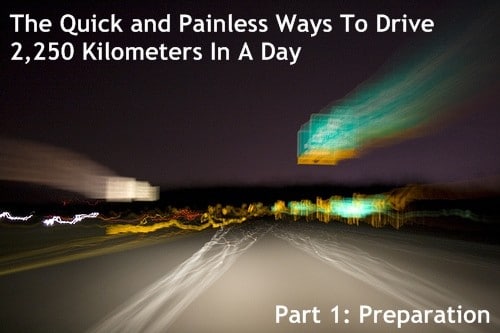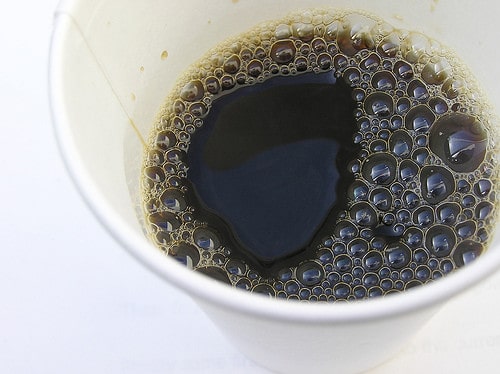Driving 2,250 kilometers (approximately 1,400 miles) in a day or a night is a straightforward task but doing so without completely feeling wiped out the entire trip requires preparation and taking advantage of your circadian rhythms. 2,250km is about the distance you’ll be driving from Washington DC to Miami or from London to Istanbul. It’s tolling on the body and mind so make it easy on yourself.

Dress Appropriately
Wear loose clothing so your skin and muscles don’t get irritated and to prevent the restriction of blood flow. Same as when you’re flying, traveling for more than 4 hours at a time increases your risk of blood clots (for up to 4 weeks). Make it easier on your body by giving it as much room to breathe as possible. Wear loose socks as well since the blood supply to and from the legs is affected most.
Caffeine, Snacks, and More Caffeine
 Ideally you want to drive in segments of about 500km (~300 miles) depending on how fast you’re driving. (Here’s how to avoid a speeding ticket just in case.) Pick your driving segments according to your bladder and ability to concentrate and stick with it. Limit yourself to 8 oz. of caffeinated beverage for the first 100 mile segment so you’re not pulling over early to go to the bathroom.
Ideally you want to drive in segments of about 500km (~300 miles) depending on how fast you’re driving. (Here’s how to avoid a speeding ticket just in case.) Pick your driving segments according to your bladder and ability to concentrate and stick with it. Limit yourself to 8 oz. of caffeinated beverage for the first 100 mile segment so you’re not pulling over early to go to the bathroom.
Also, you’ll be better able to drive further if your car is stocked with high fiber snacks (apricots, almonds, etc.) which will fill you up without insulin fatiguing you after you eat.
Set The Trip Counter To Zero
Head over to a gas station, fill your tank full and reset the trip counter. While you should listen to your body (as you fatigue or get bored) you’ll find it easier to have a 500km segment goal to make a long trip seem shorter. It’s all about getting into the flow of each segment and not stopping in the middle of any of them. Make each stop a gas, bathroom, stretch, and go. You can cover a lot of ground this way, especially towards the end when you’re concentration is starting to fade.
Use Your Body Clock
 The best time to drive is when there’s nobody else on the road which is generally in the middle of the night, conflicting with your normal human circadian rhythms. You want to free yourself from the mental wear of having to stop, go, and deal with other drivers (who don’t drive as well as you, of course).
The best time to drive is when there’s nobody else on the road which is generally in the middle of the night, conflicting with your normal human circadian rhythms. You want to free yourself from the mental wear of having to stop, go, and deal with other drivers (who don’t drive as well as you, of course).
If you’re normally a morning person, active and alert during the day shift your body clock with peanuts to get up a few hours earlier when the roads are clear. Night owls can do the same, except by leaving after the night rush, if there is one.
Now For The Actual Driving
Preparation is easy and breaking your trip down into manageable segments isn’t too difficult either…at first. Hours on the road will begin to take their toll, your eyes will get hazy, and you’ll want to stop more and more frequently. Tomorrow I’ll give you my tricks from the road to keep you alert and safe while at the same time being as lazy as possible.
[photos by: BottleLeaf, libraryman, !*S4N7Y*!]












Great tips. I’m looking forward to part 2. As a family, most of the time we choose to travel by car than flying for budget reason. These will be a great resource for us.
I totally agree on ‘Body Clock’ tip. One trip we attempted to drive overnight and couldn’t make it. We learned to adjust our driving to our normal routine.
It’s better to go with your body than fight it. Took me a while to learn that lesson. It can be done I suppose but it’s less safe and you end up completely drained when you get to point B.
Very useful tips in this post. So far, I haven’t driven for longer than 4-5 hours in a row. Not sure how I’d cope with a longer drive. I think getting enough energy snacks or coffee is the most vital part. Driving long distances when you’re feeling sluggish and tired is not to recommend.
I’ve done lots of long 20+ hour trips and don’t push myself any more. I sleep when I need it and aren’t racing against the clock all the time. They say driving sleepy is bad as driving drunk and I believe it. Starting to nod off as you drive is a scary feeling.
This topic is popular in Australia in general with its large distances, often with few intervening towns. Campaigns such as “drive, revive, survive” are popular every holiday period when many head out to cover long distances, often on single lane long distance highways as are characteristic of most of our inland roads (after all there aren’t that mnay folks travelling on them). Start a long drive by being well rested and ready to go. The major focus of advice in campaigns here is to have a small break every TWO hours – that is roughly every two hundred kilometres (120 miles) and well under the average refuelling distance. Also stay hydrated with water even if that causes more toilet visits as water keeps the body going and more alert, along with suitable snacks.
Great advice Mark on using your bladder as a way to keep alert. You’ll certainly be kept awake by the urge to go to the bathroom. My driving segments may be a bit ambitious (~500km) depending on the circumstances and it’s always best to stop *before* you start getting too tired.
I don’t think that I’ve ever driven such a large distance at one sitting. Doubt that I ever will at this point in my life. But your trips are great for those who dare.
It’s grueling not as fun as taking your time on the journey!
I love this. I recently drove from Denver to Tucson and back (and will do it again in less than a week). On the way there I left at 8PM and arrived at 9:30 AM. Caffiene is definitely your friend, but so are B vitamins. Try taking a B complex, it will help perk you up and reduce the stress of driving. A great purchase at gas stations is 5 Hour Energy or, my favorite, 5 Hour Energy Extreme. They have a ton of B vitamins and caffiene. Although they say they don’t let you crash (a terrible term when you’re driving) they will lead to a crash (mental or otherwise) after a long stretch driving. They do have a massive benefit of being only about one ounce, so you don’t need to worry about constant bathroom breaks. I like to alternate between 5 Hour Energy and Yerba Mate. I bring a mug, a bombilla, and a bag of yerba mate when I drive. Most gas stations will let you take hot water for free, so it’s a cheap way to wake yourself up. The hot, not terribly tasting liquid also prevents you from drinking too much at a time – further reducing your need for bathroom breaks. Inevitably, after driving through the night, you’ll reach a point where you start nodding off. At this point, I pull over and either slam a 5 Hour Energy and take a 15 minute nap or get out of the car and do jumping jacks, pushups and sprints. When you start to lose it, either sleep or get your blood flowing.
Brian, thanks for the great tips. I especially like the idea of getting hot water. (A reason I bring my own tea bags when I travel. The water is free but they’ll charge you a dollar or two for tea when you can buy 100 bags for a little more.)
I’ve definitely done the pull over and run around, jumping jacks routine. Makes you look funny but some of the best stimulants are produced by the body itself, you just have to work a bit to get them 🙂